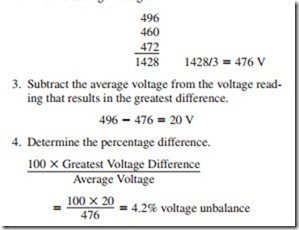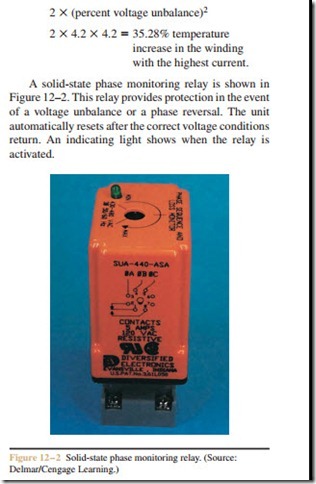If two of the lines supplying power to a three-phase motor are reversed, it will cause the motor to reverse the direction of rotation. This can be a serious problem with some types of equipment. Unintended reversal of direction can cause gear teeth to shear, chains to break, and the impeller of submersible pumps to unscrew off the end of the motor shaft. It can not only cause dam- age to equipment but also injury to operators or personnel in the vicinity of the machine.
Phase failure occurs when power is lost to one of the lines supplying power to a three-phase motor. The motor will continue to operate but will draw an excessive amount of current. In this condition, the overload relay should cause the motor starter to disconnect the motor from the power line if the overload heaters have been sized correctly. Single phasing will cause the two phases that remain energized in a three-phase motor to increase current by an average of 173%.
voltage. Figure 12–1 shows the approximate change in full load current and starting current for typical electric motors when operated over their rated voltage (110%) and under their rated voltage (90%). Motors are in- tended to operate on systems with balanced voltage (the voltage is the same between all phases). Unbalanced voltage is one of the leading causes of motor failure. Unbalanced voltage is generally caused when single- phase loads are supplied by three-phase systems.
Determining the Amount of Voltage Unbalance
Figure 12–1 refers to the voltage across the phase conductors of a balanced three-phase system as measured between phases AB, BC, and AC. In other words,
Effects of Voltage Variation on Motors
Motors are affected when operated at other than their rated nameplate voltage. NEMA rated motors are de- signed to operate at plus or minus 10% of their rated
the table indicates the effect on motor current when voltage is greater or less than the motor nameplate rating in a balanced system. Greater harm is caused when the voltages are unbalanced. NEMA recommends that the unbalanced voltage not exceed plus or minus 1%. The following steps illustrate how to deter- mine the percentage of voltage unbalance in a three- phase system:
1. Take voltage measurements between all phases. In this example, assume the voltage between AB = 496 volts, BC = 460 volts, and AC = 472 volts.
2. Find the average voltage.
A solid-state phase monitoring relay is shown in Figure 12–2. This relay provides protection in the event of a voltage unbalance or a phase reversal. The unit automatically resets after the correct voltage conditions return. An indicating light shows when the relay is activated.
Heat Rise
The percentage of heat rise in the motor caused by the voltage unbalance is equal to twice the percent squared.
1. A three-phase motor has a nameplate current of 56 amperes. If one phase is lost and the motor begins single-phasing, what would be the average amount of current flowing in the two remaining phases?
2. NEMA rated motors are designed to operate at what percentage of their rated voltage?
3. A three-phase motor is rated to operate on 208 volts. The following voltage readings are taken: A-B 177, A-C 187, B-C 156. What is the percentage of temperature increase in the phase with the highest current draw?

